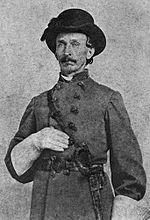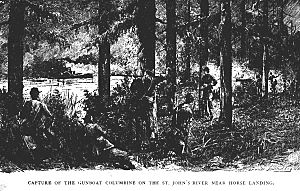J. J. Dickison facts for kids
Quick facts for kids
John Jackson Dickison
|
|
|---|---|

Then-Capt. John Jackson Dickison (1864)
|
|
| Nickname(s) | "The Swamp Fox" |
| Born | March 27, 1816 Monroe County, Virginia (now part of West Virginia) |
| Died | August 20, 1902 (aged 86) Okahumpka, Florida |
| Place of burial |
Evergreen Cemetery, Jacksonville, Florida
|
| Allegiance | |
| Service/ |
|
| Years of service | 1862–1865 |
| Rank | |
| Commands held | |
| Battles/wars | American Civil War
|
| Other work | Adjutant General of Florida, author |
John Jackson Dickison (1816–1902), often called J. J. Dickison, was an officer in the Confederate States Army during the American Civil War. He is best known for leading a daring attack that captured a Union warship, the USS Columbine. This was a rare event where land troops captured a ship. It was also the only time in U.S. history a cavalry unit sank an enemy gunboat. Dickison and his soldiers won many battles against Union forces in Florida, including the Battle of Gainesville. Sadly, one of his sons, who fought alongside him, was killed during a raid.
Contents
Early Life and Training
Dickison was born in Monroe County, Virginia, which is now part of West Virginia. He grew up in South Carolina, where he went to school. Later, he became a successful cotton merchant in Georgetown. In 1857, Dickison moved to Ocala, Florida, and bought a large farm called "Sunnyside." His farm did very well, and his business continued to grow.
Dickison also joined the South Carolina Militia. This is where he got his military training. He became an officer in the cavalry, which is a unit of soldiers who fight on horseback.
Joining the Civil War
When the American Civil War began, Confederate leaders asked Dickison to join them. He agreed on December 12, 1861. He started as a Lieutenant under Captain John M. Martin. He served in the Marion Light Artillery at Fort Clinch.
On July 2, 1862, Dickison was promoted to captain. He was then ordered to create and lead a new cavalry unit. This unit was Company H of the 2nd Florida Cavalry Regiment. His commanding officer, Major General Sam Jones, praised him after a successful raid. General Jones noted Dickison's "gallant and valuable services."
The Battle of Horse Landing
Lola Sánchez became a Confederate spy after Union soldiers wrongly imprisoned her father. Her home, near the St. John's River, was taken over by Union forces. On May 21, 1864, Lola overheard three Union officers talking about a secret plan. They planned a surprise attack on Confederate forces the next morning. Their goal was to get supplies for the Union Army in St. Augustine.
Lola knew she had to warn Captain Dickison at Camp Davis, which was close by. Her sisters helped her by covering for her absence. That night, Lola rode alone through the forest to reach the ferry. The ferryman watched her horse while she crossed the river. She found a Confederate guard and told him what she heard. Since the guard could not leave his post, he lent her his horse. She then rode to Dickison's camp and told him everything. After the meeting, she quickly returned home. The whole trip took only an hour and a half, and the Union soldiers at her house did not notice she was gone.
That night, Dickison and his men crossed the St. Johns River. They set a trap for the Union transport and gunboat. On the morning of May 22, the Union forces were ambushed. Dickison raised his saber, signaling his men to attack. Confederate soldiers had hidden artillery guns along the riverbanks. They opened fire on the approaching Union gunboats.
The fight, known as the "Battle of Horse Landing," happened south of St. Augustine. Union Colonel William H. Noble was wounded and captured. Most other Union soldiers were either captured or killed. Dickison and his men captured the USS Columbine. This was a side-wheel steamer and gunboat. Ensign Frank Sanborn, the ship's commander, said he saw nothing suspicious until his ship was close to the landing. Then, two hidden artillery guns opened fire. His ship's steering chains were cut, and the pilot jumped overboard. The ship then ran aground on a mud bank.
After taking all useful supplies and weapons, the Confederates damaged the ship and set it on fire. Out of 148 men on the Columbine, only 66 survived. This was one of the few times a Union warship was captured by land forces during the Civil War. It was also the only known time in U.S. history that a cavalry unit sank an enemy gunboat. The Confederates also captured a Union pontoon boat. They renamed it The Three Sisters to honor Lola Sánchez and her sisters.
The Battle of Gainesville
In June and July 1864, Dickison and his men fought several small battles. His son, Sergeant Charles Dickison, was part of his unit. On August 2, 1864, Dickison stopped a Union group and made them surrender. He did not know some prisoners had hidden weapons. Suddenly, the prisoners pulled out their weapons and started shooting. Dickison's son Charles was injured and died from his wounds.
On August 17, 1864, Dickison learned that Union soldiers had burned Confederate train cars in Starke. Dickison and his men then headed to Gainesville. They went to fight the enemy in what became known as the Battle of Gainesville. This battle is different from an earlier skirmish in Gainesville in February 1864.
Gainesville was held by Union soldiers from Ohio and Massachusetts. They were completely surprised by Captain Dickison and his men. The Union forces were scattered. Before they ran into the woods, 28 were killed, 5 were wounded, and over 200 were captured. The remaining Union forces in north-central Florida went back to their bases in Jacksonville and St. Augustine. Gainesville stayed under Confederate control for the rest of the war.
However, some Union units still tried minor raids. On October 24, 1864, a group of Union cavalry returned to Gainesville to steal things. Dickison was warned and quickly attacked. A 40-minute gunfight followed. Ten Union soldiers were killed, and 23 were taken prisoner. This included eight wounded men.
Family Life
In 1844, John Dickison married Mary Margaret Lester. They had a son named Charles Bannister. Sadly, Mary died in childbirth in 1856.
In 1848, Dickison married Mary Elizabeth Ling. They had two sons, Robert Ling and John Jackson Jr., and a daughter, Mary Lucile.
Later Years and Legacy
Dickison was captured near Waldo and imprisoned. He was promoted to Colonel in May 1865, just a few days after all Confederate troops surrendered. He was released on May 20, 1865.
Dickison helped Confederate Secretary of War John C. Breckinridge escape to Cuba. He gave Breckinridge a boat, which was a lifeboat taken from the captured USS Columbine. Dickison remained active in Confederate veteran groups. He was elected Commander of the Florida Division of United Confederate Veterans six times. In the late 1870s, he served as Florida's Adjutant General. Dickison also wrote the Florida section of a 12-volume book called Confederate Military History.
Dickison and his wife, Mary Elizabeth Dickison, lived at Bugg Spring in Okahumpka, Florida, for many years after the war. In 1889, Mrs. Dickison finished her book, "Dickison and His Men: Reminiscences of the War in Florida."
In 1902, Dickison died at his home in Bugg Spring. He is buried in Evergreen Cemetery in Jacksonville, Florida. A special marker was placed where Dickison and his men captured the USS Columbine. Another marker is in Gainesville, showing where the "Battle of Gainesville" happened. There is also a marker in Waldo, Florida, where Camp Baker was located. This was a camp where Dickison and his men stayed during the last weeks of the war. The Dickison cottage in Bugg Spring is still standing today and is a private guest house.
See also
- American Civil War
- Lola Sánchez



